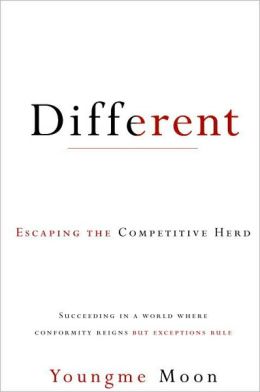I like to compete. When we’re cycling with a friend, it turns out to be a competition of who’s first up the hill. When we are shooting hoops, we always count the score. It’s fun, makes the game more interesting, and provides a solid measure for development. We are competing to be better.
But when it comes to business, this idea resonates strongly with me: Don’t compete to be better, compete to be different.
We’ve seen so many times that competing to be better just makes everyone similar. Think about cars. Jeep used to be rugged, Volvo used to be safe, Audi used to be sporty. Now every car is rugged and safe with great performance and modest mileage.
All airlines are the same. All bottled water is similar. Every PC or printer is the same.
 Therefore, I was expecting a lot when I got my hands on a book titled Different: Escaping the Competitive Herd by Youngme Moon, a professor at the Harvard Business School. She writes about how markets evolve, why that leads to similarity, and how to stand out of the herd.
Therefore, I was expecting a lot when I got my hands on a book titled Different: Escaping the Competitive Herd by Youngme Moon, a professor at the Harvard Business School. She writes about how markets evolve, why that leads to similarity, and how to stand out of the herd.
Typically, companies try to make their product better, and they do this by:
- Augmentation by addition (more features!). Mobile phones used to be for calling…
- Augmentation by multiplication (wider selection!). Coca cola light, classic, zero, vanilla, cherry, zero caffeine free, etc…
Customers expect the products to get better and the selection to get wider. What was great last year is not nearly good enough this year. Or that’s the belief that businesses have. This augmentation treadmill leads to over-serving and inflated set of benefits. I think Horace Dediu has written about similar idea in his analysis about how the iPhone is able to maintain its price: “In the case of the iPhone the tenacious retention of its ASP indicates that the point of over-service has not been reached.”
Prof. Moon goes on to introduce Idea Brands. They are brands (businesses), who are more interested in separation that comparison. There are three categories of idea brands:
- Reverse brands.
- Breakaway brands.
- Hostile brands.
Reverse brands switch gears to reverse and actually remove benefits even if clients expect and want the benefits. Reverse brands’ products are stripped down, but not in the way the low-cost businesses operate. K-mart or Ryanair are not reverse brands. Reverse brands trim and eliminate features but at the same time introduce some other form of extravagance or splendour. Prof. Moon uses early Google as an example: back then Google removed all popular portal features and focused on search only. It was fast, efficient and clean – totally unlike Yahoo or AOL or Altavista at the time.
Breakaway brands position their product according to different, unexpected standards. They frame themselves differently. Examples include the Simpsons: it was a cartoon but totally different from any cartoons seen before. The Simpsons provided cultular criticism and complex jokes. Another example is the Swiss watch maker Swatch. Swatch didn’t have anything to do with the Swiss clock making traditions (i.e. long lasting, valuable, handcrafted time pieces). Instead Swatch positioned themselves as a fashion business. They had a huge selection, constantly renewing, and they were quick to introduce new models.
Hostile brands don’t compromise for anyone. They emphasize even their flaws and try to make a statement in doing so. They draw a line and know that only some will step over – but those who do, will be loyal customers. Birkenstock is ugly but stands for comfort. Many drinks try to play the hostile brand card: Devil Springs Vodka – not for celebrating your sister’s birthday. When Mini Cooper launched in the US in 2002 they didn’t try to convince us that the car is bigger than it looks or that it’s spacious enough. Instead they said this is a really small car – but not a boring car at all. Hostile brands know that traction requires friction.
Differentiation is not a form of competition but escape from the competition altogether.
Oh, about the book. I’d say it scores 3.5/5. The ideas are very interesting but not too strongly discussed. Evidence was too often just anecdotal and conversational. And there was too much talk about “my students, who did this ‘n that”.